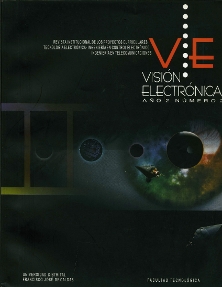DOI:
https://doi.org/10.14483/22484728.18376Publicado:
2018-08-13Número:
Vol. 1 Núm. 2 (2018): Edición especialSección:
Visión InvestigadoraDesign and simulation of microfluidic device for the detection of HIV
Diseño y simulación de dispositivo de microfluídica para detección de VIH
Palabras clave:
Detection, Device, HIV, Microfluidics, Reaction (en).Palabras clave:
Detección, Dispositivo, HIV, Microfluidica, Reacción (es).Descargas
Resumen (en)
This article presents a diagnostic device model, which by using chemical reagents and microfluidics that makes a sort of particle separation and was developed to diagnose an acquired viral immunodeficiency. The device allows to isolate leukocytes and apply a reagent that measures the presence or absence of this virus. The design on the other hand uses tools such as SolidWorks and Autodesk Simulation, which, with the rupture of the membranes and the separation of their components, allows the chemical reaction in the particles and the detection of the virus.
Based on the choice of particle analysis and validating the performance of the fluid maintained in the filter stage, which is represented by 5 flow lines, it shows the movement of 5 particles with the same diameter. Additionally, three tests were performed that varied the diameter of the particles to 5 μm, 10 μm and a larger diameter particle (15 μm). The results show that, with a diameter of 5 μm, the particles move smoothly and the filter can reach the next stage. The particles of 10 μm in diameter presented a normal blood flow, however, an obstruction in the particles of 15 μm in diameter can be observed.
Resumen (es)
Este artículo presenta un modelo de dispositivo de diagnóstico, que mediante el uso de reactivos químicos y microfluidos que hace una especie de separación de partículas y se desarrolló para diagnosticar una inmunodeficiencia viral adquirida. El dispositivo permite aislar leucocitos y aplicarles un reactivo que mide la presencia o ausencia de este virus. El diseño por otra parte utiliza herramientas tales como SolidWorks y Autodesk Simulation, que, con la ruptura de las membranas y la separación de sus componentes, permite la reacción química en las partículas y la detección del virus.
Con base en la elección del análisis de partículas y validando el rendimiento del fluido mantenido en la etapa de filtro, el cual está representado por 5 líneas de flujo, muestra el movimiento de 5 partículas con el mismo diámetro. Adicionalmente, se realizaron tres pruebas que variaron el diámetro de las partículas para 5 μm, 10 μm y una partícula de mayor diámetro (15 μm). Los resultados muestran que, con un diámetro de 5 μm, las partículas se mueven suavemente y el filtro puede alcanzar la siguiente etapa. Las partículas de 10 μm de diámetro presentaron un flujo sanguíneo normal, sin embargo, se puede observar una obstrucción en las partículas de 15 μm de diámetro.
Referencias
C. Yu Chan, V. N. Goral, M. E. Rosa, T. Jun Huang and P. Yuen, “A polystyrene-based microfluidic device with three-dimensional interconnected microporous walls for perfusion cell culture”, Biomicrofluidics, vol. 8, no. 4, 2014. https://doi.org/10.1063/1.4894409
C. Chi, et al., “Microfluidics-based diagnostics of infectious diseases in the developing world”, Nature Medicine, vol. 17, no. 8, 2011, pp. 1015-1019. https://doi.org/10.1038/nm.2408
Y. Ghallab and W. Badawy, “Lab-on-a-chip Techniques, Circuits, and Biomedical Aplications”, United States: Artech Haouse, 2010.
G. Binyamin, T. Boone, H. Lackritz, A. Ricco, A. Sassi and S. Williams, “Plastic microfluidic devices: electrokinetic manipulations, life science applications, and production technologies”, Lab on a Chip, 2003, pp. 83-111. https://doi.org/10.1016/B978-044451100-3/50005-X
H. Joenssonand H. Andersson, “Droplet microfluidics-a tool for protein engineering and analysis”, Lab on a Chip, no. 24, 2011. https://doi.org/10.1039/c1lc90102h
N. Nguyen, “Fundamentals and Applications of Microfluidics”, Boston: Artech House, 2002.
P. Christodoulies, G. Florides, K. Kalli, C. Koutsides, L. Lazari, M. Komodromos and F. Dias, “Microfluidics in microstructure optical fibers: heat flux and pressure-driven and other flows”, Procedia IUTAM, vol. 11, 2014, pp. 23-33.
F. Banica, “Chemical Sensors and Biosensors Fundamentals Applicationes”, John Wiley & Sons, Ltd, 2012. https://doi.org/10.1002/9781118354162
A. Avila and Y. Mora, “Designing and simulating a nitinol-based micro ejector”, Revista Ingeniería e Investigación, vol. 32, no. 1, 2012, pp. 42-47.
J. Ducrée, “Next-generation microfluidic lab-on-a-chip platforms for point-of-care diagnostics and systems biology”, Procedia Chemistry, vol. 1, no. 1, 2009, pp. 517-520. https://doi.org/10.1016/j.proche.2009.07.129
Cómo citar
APA
ACM
ACS
ABNT
Chicago
Harvard
IEEE
MLA
Turabian
Vancouver
Descargar cita
Licencia
Derechos de autor 2018 Visión electrónica

Esta obra está bajo una licencia internacional Creative Commons Atribución-NoComercial 4.0.
.png)
atribución- no comercial 4.0 International







.jpg)





